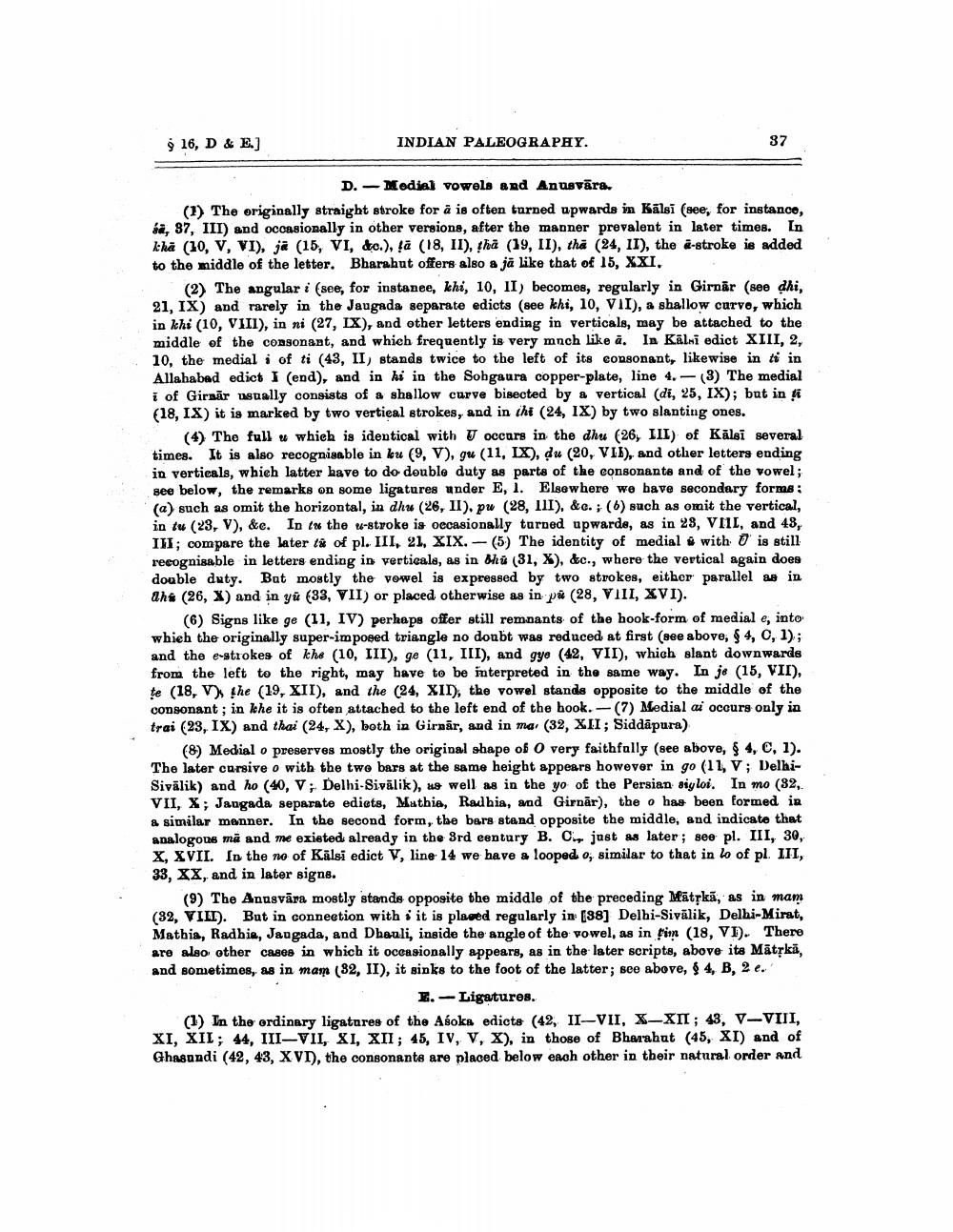________________
9 16, D & E.]
INDIAN PALEOGRAPHY.
37
D. - Medial vowels and Anusvāra. (1) The originally straight stroke for å is often turned upwards in Kālsi (see, for instance, sa, 87, III) and occasionally in other versione, after the manner prevalent in later times. In tha (10, V, VI), ja (15, VI, do.), lă (18, II), tha (19, II), thă (24, II), the 2-stroke is added to the middle of the letter. Bharahut offers also a ja like that of 15, XXI.
(2) The angular i (see, for instanee, khi, 10, II) becomes, regularly in Girnar (see dhi, 21, IX) and rarely in the Jaugada separate edicts (see khi, 10, VII), a shallow curvo, which in khi (10, VIII), in ni (27, IX), and other letters ending in verticals, may be attached to the middle of the consonant, and which frequently is very much like å. In Küli edict XIII, 2, 10, the medial i of ti (43, II) stands twice to the left of its consonant, likewise in ti in Allahabad edict I (end), and in hi in the Sobgaura copper-plate, line 4.-(3) The medial i of Girnăr usually consists of a shallow curve bisected by a vertical (di, 25, IX); but in ti (18, IX) it is marked by two vertieal strokes, and in iht (24, IX) by two slanting ones.
(4) The full whieh is identical with U occurs in the dhu (26, III) of Kälsi several times. It is also recognisablo in lere (9, V), gu (11, IX), du (20, VII), and other letters ending in vertieals, which latter have to do double duty as parts of the consonants and of the vowel; see below, the remarks on some ligatures under E, 1. Elsewhere we have secondary forms: (a) such as omit the horizontal, in dhu (26, II), pw (28, III), &c. ; (b) such as omit the vertical, in tu (23, V), &e. In to the u-stroke is occasionally torned upwarde, as in 28, VIII, and 48, IHI; compare the later tå of pl. III, 21, XIX. - (5) The identity of medial with 7 is still recognisable in letters ending in verticals, as in Bhú (31, X), &c., where the vertical again does double duty. But mostly the vowel is expressed by two strokes, either parallel as in ahs (26, X) and in yü (33, VII) or placed otherwise as in pa (28, VIII, XVI).
(6) Signs like ge (11, IV) perhaps offer still remnants of the hook-form of medial e, into whieh the originally super-imposed triangle no doubt was reduced at first (see above, $ 4, 0, 1); and the e-strokes of the (10, III), ge (11, III), and gye (42, VII), which slant downwards from the left to the right, may have to be interpreted in the same way. In je (15, VII), te (18, V) the (19, XII), and the (24, XII), the vowel stands opposite to the middle of the consonant; in khe it is often attached to the left end of the book. -(7) Medial ai occurs only in trai (23, IX) and thai (24, X), both in Girnār, and in mai (32, XII; Siddapura)
(8) Medial o preserves mostly the original shape of O very faithfully (see above, $ 4, 0, 1). The later corsive o with the two bars at the same height appears however in go (11, V; DelhiSivālik) and ho (40, V; Delhi-Sivälik), s well as in the yo of the Persian siyloi. In mo (32, VII, X; Jangada separate ediets, Mathia, Radhia, and Girnār), the o has been formed in & similar manner. In the second form, the bars stand opposite the middle, and indicate that analogous ma and me existed already in the 3rd eentury B. C. just as later ; see pl. III, 30, X, XVII. In the no of Kälsi edict V, line 14 we have a looped o, similar to that in lo of pl. III, 33, XX, and in later signs.
(9) The Anusvāra mostly stande opposite the middle of the preceding Mātkā, as in mam (32, VII. But in connection with i it is placed regularly in [38] Delhi-Sivälik, Delhi-Mirat, Mathia, Radhim, Jaugada, and Dhauli, inside the angle of the vowel, as in tim (18, VI). There are also other cases in which it occasionally appears, as in the later scripte, above its MātȚkā, and sometimes, as in mam (82, II), it sinks to the foot of the latter; sce above, $4, B, 2 e.
E. - Ligatures. (1) In the ordinary ligatures of the Asoka edicts (42, II-VII, X-XII; 43, V-VIII, XI. XIL; 44. III-VII, X1, XII; 45, IV, V, X), in those of Bharahut (45, XI) and of Ghasundi (42, 43, XVI), the consonants are placed below each other in their natural order and




